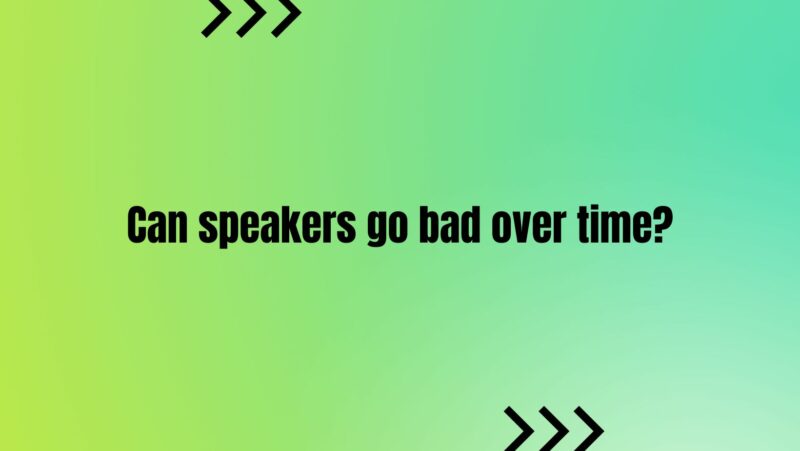In the realm of sensory experiences, speakers serve as the conduits that bridge the gap between the digital and auditory worlds. From the dulcet tones of music to the resonating dialogues of cinema, these devices play a pivotal role in shaping our acoustic encounters. As time weaves its narrative, a pertinent question arises: Can speakers go bad over time? This inquiry unravels a symphony of factors, ranging from technological intricacies to environmental influences. In this article, we embark on a journey to uncover the dynamics that lead to the deterioration of speakers and their eventual decline.
I. The Harmonics of Deterioration
At the heart of a speaker’s operation lies an intricate dance of components. The diaphragm, or cone, vibrates in response to electrical signals, generating sound waves that reach our ears. Yet, this rhythmic interplay is not impervious to the relentless march of time and the forces that accompany it.
II. Components Under Siege: Wear and Tear
Speakers, like all mechanical systems, are subject to wear and tear. The diaphragm, composed of materials like paper, plastic, or metal, undergoes repetitive stress as it vibrates to produce sound. These movements cause microscopic wear that accumulates over time, leading to a gradual decline in the diaphragm’s ability to accurately reproduce sound frequencies.
III. The Strain on the Voice Coil
The voice coil, a vital component responsible for moving the diaphragm, is subject to both mechanical and thermal stress. The interaction between the voice coil and the magnetic field generated by the speaker’s magnet assembly generates motion. However, as electrical currents pass through the voice coil, it generates heat. Over time, this heat can lead to the degradation of the coil’s insulation, potentially resulting in shorts or open circuits that compromise the speaker’s performance.
IV. Suspended Reality: The Surround and Suspension System
A speaker’s suspension system, which includes the surround and other elements, plays a crucial role in maintaining diaphragm alignment and movement. However, the surround is vulnerable to the passage of time. Exposure to air, temperature fluctuations, and mechanical stress gradually weaken the surround’s flexibility. Cracking or tearing of the surround can cause imprecise diaphragm movement, resulting in distorted sound and reduced audio quality.
V. The Power Play: Pushing the Limits
The power input to a speaker significantly affects its lifespan. While higher power can yield greater volume and dynamic range, it can also push components to their limits. Playing audio at excessive volumes for prolonged periods can cause mechanical stress and heat buildup, accelerating the deterioration of components. Though many modern speakers include protective mechanisms, such as thermal sensors and overload circuits, excessive power usage can still contribute to speaker degradation.
VI. Environmental Influences and Corrosion
Speakers coexist with their surroundings, making them susceptible to external factors. Humidity, temperature fluctuations, and exposure to sunlight can degrade materials and corrode connections. Outdoor speakers, designed to withstand harsh conditions, showcase manufacturers’ efforts to counteract environmental influences. Proper placement and care can mitigate the impact of these factors.
VII. Listener Behavior: A Key Factor
The way a speaker is used plays a substantial role in its deterioration. Extended periods of high-volume usage can accelerate wear, particularly in components like the diaphragm and suspension system. Additionally, playing distorted or overly bass-heavy content can strain these components. Practicing mindful usage, with occasional rests and controlled volume levels, can extend a speaker’s life.
VIII. Maintenance and Prolonged Lifespan
While speakers are bound to deteriorate over time, maintenance practices can significantly extend their functional life. Regular cleaning to prevent dust accumulation, visual inspections for signs of wear, and prompt addressing of issues can prevent minor problems from escalating. Adhering to manufacturer guidelines for usage and care is integral to a speaker’s extended lifespan.
IX. The Inevitable Decline
The march of time spares no device, and speakers are no exception. The wear of components, the cumulative impact of usage and environmental influences, and the passage of countless hours contribute to a speaker’s eventual decline. The life expectancy of a speaker varies, with budget options potentially showing signs of deterioration within a few years and premium models, maintained and not overdriven, lasting for decades.
Conclusion
The question, “Can speakers go bad over time?” delves into the intricate mechanisms that govern the life cycle of these auditory companions. While the deterioration of speakers is an undeniable reality, the interplay of technological advancements, usage patterns, and maintenance practices can influence the pace of decline. Understanding the underlying causes equips us to make informed decisions about speaker selection, usage habits, and preservation methods. As the melody of existence continues, so too does the symphony of sound produced by these remarkable devices, woven into the very fabric of our lives.


